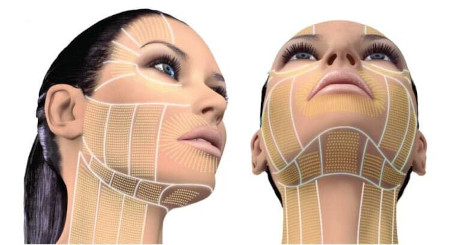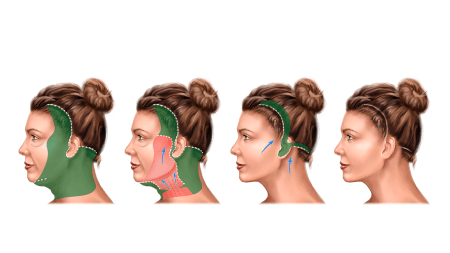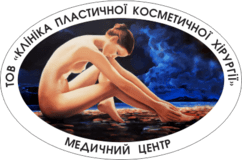Ukraine, 36011, Poltava, prospekt Pervomayskiy 9 +38 (0532) 56-02-11+38 (095) 688 25 07
Contraindications for SMAS lifting
 To preserve youth and attractiveness of the face is the dream of many men and women. The absolute leader in terms of rejuvenation and renewal of appearance is SMAS lifting. The technique is based on the process of surgical tightening of the musculo-aponeurotic system - the subcutaneous structure that connects the dermis and facial muscles. The result of the action is not only the elimination of wrinkles and drooping of the corners of the eyes and lips, but also the creation of ideal facial proportions inherent in a person, without the effect of extremely taut skin. If you want to look better, but it is too early for serious plastic surgery, you can resort to gentle thread lifting, which is also done in our Clinic.
To preserve youth and attractiveness of the face is the dream of many men and women. The absolute leader in terms of rejuvenation and renewal of appearance is SMAS lifting. The technique is based on the process of surgical tightening of the musculo-aponeurotic system - the subcutaneous structure that connects the dermis and facial muscles. The result of the action is not only the elimination of wrinkles and drooping of the corners of the eyes and lips, but also the creation of ideal facial proportions inherent in a person, without the effect of extremely taut skin. If you want to look better, but it is too early for serious plastic surgery, you can resort to gentle thread lifting, which is also done in our Clinic.
SMAS lifting - pros and cons
In comparison with the classical facelift, when the deep subcutaneous layers of the dermis are not affected, the SMAS operation has undeniable advantages:
- increased effectiveness of the technique even in the older age group;
- smoothing not only small "mimic" wrinkles, but also deep skin folds and creases;
- getting rid of hanging skin flaps;
- the incision of the eyes and the natural line of the mouth remains unchanged, due to the absence of tension on the integument;
- the possibility of correcting the outlines of the face, returning it to its original natural contours, relief and volume, while maintaining the individuality of the features;
- long-lasting effect over the entire surface, due to the effect on all areas of the face;
- almost complete invisibility of postoperative sutures.
However, with all the positive aspects, this type of plastic also has its drawbacks:
- sufficient severity, complexity and duration of the operation;
- high qualifications and experience of a surgeon;
- increased possibility of nerve damage, which entails mimic disorders and loss of sensitivity, due to exposure to the deep layers of the skin;
- the use of general anesthesia;
- long recovery period.
To shape the oval of the face and sharpen the contours of the neck, remove the drooping of tissues in the cheek area, as well as smooth out nasolabial wrinkles, the Clinic's specialists recommend SMAS-lifting of the lower ⅔ of the face.
When is the procedure prohibited?
Like any surgical intervention, SMAS lifting has a number of standard and specific contraindications:
- the phase of pregnancy and breastfeeding is standard, since the operation is characterized by high trauma, the use of general anesthesia and potent drugs;
- the presence of a pacemaker in a patient indicates unsatisfactory work of the cardiovascular system, which immediately does not allow surgical intervention;
- installed metal implants in the operable area, except for dental ones. However, discomfort will be felt around them;
- connective tissue diseases (rheumatoid arthritis, lupus erythematosus), diabetes mellitus, problems with blood clotting, as they complicate rehabilitation and can cause complications;
- the presence of non-absorbable silicone-based fillers in the subcutaneous layers. When manipulating the muscles and epidermis, they will create bumps and uneven relief. Recommended for removal;
- nervous ailments, in particular, epilepsy. Patients with such a history are prone to complications from the nervous and respiratory systems. What is unacceptable during the operation;
- bacterial, viral, fungal diseases that contribute to the risk of tissue infection and prolong the recovery period;
- the patient's skin tendency to develop keloid scars complicates the rehabilitation process and does not guarantee aesthetic appeal after healing;
- carry out the operation until the patient reaches 35 years of age. Until this period, the musculo-aponeurotic framework has not yet been properly formed. Therefore, there will be no point in a facelift.
Be that as it may, the decision on the expediency of the operation is made by the doctor after an appropriate examination, tests, personal characteristics of the patient.
Potential complications of SMAS tightening and what to do if they occur
 SMAS lifting is a rather serious intervention in the body, which can lead to additional problems and repeated corrective surgeries:
SMAS lifting is a rather serious intervention in the body, which can lead to additional problems and repeated corrective surgeries:
- Bruises, swelling and bruising. Usually, such subcutaneous hemorrhages go away in 1-2 weeks. However, sometimes, the blood still leaks and causes pain. To get rid of this, you need to bandage the vessel and pump out the accumulated blood.
- Infection of the operable area. To avoid this, the doctor prescribes antibiotics. If they do not work, the wound is washed and new stitches are applied.
- Damage to the nerve trunks, which entails a decrease in sensitivity and impaired facial expressions. Over time, everything is restored under the influence of physiotherapy procedures.
- Necrosis - necrosis or death of a part of tissues. In this case, a new operation is required.
- Deformation of the contours of the face. Also, additional surgical correction is needed.
- Adverse effects of general anesthesia on the cardiovascular, digestive and other systems. Contacting a specialized specialist and prescribing appropriate treatment will correct the situation.
Most complications are prevented by taking into account the existing contraindications, the doctor's adherence to the operating techniques and the patient's adherence to the necessary postoperative recommendations.
Tips for the rehabilitation period after SMAS rejuvenation
Since the intervention during SMAS lifting is carried out deeper and more serious, the recovery period is more difficult and longer than with the usual type of lifting. On average, it lasts 2-3 weeks. On day 12, the stitches are usually removed. After that, the remaining edema and bruising gradually disappear on their own. For the first week after the operation, you need to wear a special compression bandage that supports the oval of the face, which the doctor will wear.
The patient spends approximately 1-2 days in the hospital of the Clinic under the supervision of doctors. In order for the recovery process to go as quickly, easily and without complications as possible, you need to follow the recommendations given by the surgeon:
- apply ice and cold compresses to the affected area in the first three days;
- sleep on a high pillow, do not tilt it forward and downward to reduce swelling;
- take antibiotics and other medications prescribed by your doctor;
- alcohol and smoking are prohibited;
- physical activity and stay in the sun is prohibited;
- do not steam in baths, saunas, do not take hot showers and baths.
All of these tips are valid for a period of 3 weeks to a month until recovery is over. Or as the attending physician says. It is advisable not to self-medicate in case of discomfort and pain in the operable area, so as not to aggravate the problem. You need to immediately go to the doctor for a consultation. Also, you cannot arbitrarily cancel the prescribed drugs and procedures when it seems that it has become better and the situation has stabilized.
Strict adherence to all recommendations, self-discipline and sensitive monitoring of your condition will help you to get through the postoperative time more easily and quickly return to your daily activities.
Specialists of the Clinic of Plastic and Cosmetic Surgery say that SMAS lifting is a highly effective type of facelift. Which guarantees a pronounced and stable result for 10-15 years, without additional corrections!
specialists of the Clinic for Plastic Surgery
30-06-2021
Similar news
